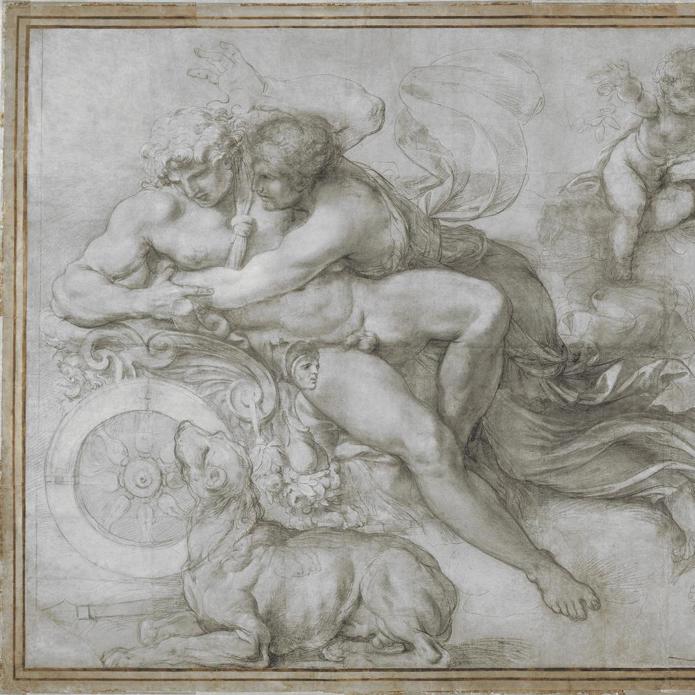Agostino Carracci, 'Cephalus carried off by Aurora in her Chariot', about 1599
About the work
Overview
A strong, determined woman is pushing a reluctant youth into a chariot on the left. This is Aurora, goddess of the dawn, who has fallen in love with a mortal, the hunter Cephalus. He resists her advances, for he is already in love with Procris, daughter of the king of Athens.
This is one of two large drawings made in connection with the ceiling decoration of the Gallery in the Palazzo Farnese in Rome, which was begun in 1597. The other drawing, A Woman borne off by a Sea God (?), is also in the National Gallery’s collection. The project, centred around the classical theme of the loves of the gods, was largely designed and executed by Annibale Carracci, with the assistance of his older brother Agostino. These large sheets represent the final stage of the preparatory drawings – the full-scale cartoons from which images were transferred onto the ceiling.
Key facts
Details
- Full title
- Cephalus carried off by Aurora in her Chariot
- Artist
- Agostino Carracci
- Artist dates
- 1557 - 1602
- Part of the series
- The Farnese Gallery Cartoons
- Date made
- about 1599
- Medium and support
- charcoal and white chalk on paper
- Dimensions
- 202.5 × 398.8 cm
- Acquisition credit
- Presented by Lord Francis Egerton, 1837
- Inventory number
- NG147
- Location
- Not on display
- Collection
- Main Collection
- Previous owners
- Frame
- 20th-century Replica Frame
Provenance
Additional information
Text extracted from the ‘Provenance’ section of the catalogue entry in Michael Levey, ‘National Gallery Catalogues: The Seventeenth and Eighteenth Century Italian Schools’, London 1986; for further information, see the full catalogue entry.
Exhibition history
-
2025The Carracci Cartoons: Myths in the MakingThe National Gallery (London)10 April 2025 - 6 July 2025
Bibliography
-
1603B. Morello, Il funerale d'Agostin Carraccio: Fatto in Bologna sua patria da gl'Incaminati academici del disegno, Bologna 1603
-
1666A. Félibien, Entretiens sur les vies et sur les ouvrages des plus excellents peintres anciens et modernes, Paris 1666
-
1672G.P. Bellori, Le vite de'pittori, Rome 1672
-
1678C.C. Malvasia, Felsina pittrice: Vite de' pittori bolognesi, Bologna 1678
-
1762A.-J. Dézallier d'Argenville, Abrégé de la vie des plus fameux peintres, nouv. éd, Paris 1762
-
1786M. Prunetti, Saggio Pittorico, Rome 1786
-
1816M. Prunetti, Descrizione storico-critico-mitologica delle celebri pitture esistenti nei reali palazzi Farnese e Farnesina in Roma, Rome 1816
-
1845G. Foggo, A Catalogue of the Pictures in the National Gallery with Critical Notes, London 1845
-
1850National Gallery, A Catalogue of Pictures in the National Gallery, London 1850
-
1867R.N. Wornum, Descriptive and Historical Catalogue of the Pictures in the National Gallery, London 1867
-
1880R. Forster, Farnesina-Studien: Ein Beitrag zur Frage nach dem Verhältnis der Renaissance zur Antike, Rostock 1880
-
1888E.T. Cook, A Popular Handbook to the National Gallery Including, by Special Permission, Notes Collected from the Works of Mr. Ruskin, London 1888
-
1925R.R. Peyre, Les Carraches, par Roger Peyre, biographie critique, Laurens 1925
-
1952R. Wittkower, The Drawings of the Carracci at Windsor Castle, London 1952
-
1954I. Lavin, 'Cephalus and Procris: Transformations of an Ovidian Myth', Journal of the Warburg and Courtauld Institutes, XVII/3-4, 1954, pp. 260-87
-
1956G. Mancini, Considerazioni sulla pittura, pubblicate per la prima volta da Adriana Marucchi con il commento di Luigi Salerno, eds A. Marucchi and L. Salerno, 2 vols, Rome 1956
-
1956D. Mahon, Mostra dei Carracci; disegni (exh. cat. Palazzo dell'Archiginnasio, 1 September - 31 October 1956), Bologna 1956
-
1965J.R. Martin, The Farnese Gallery, Princeton 1965
-
1966C. Dempsey, 'Two "Galateas" by Agostino Carracci Re-Identified', Zeitschrift für Kunstgeschichte, 1966, pp. 67-70
-
1967S.E. Ostrow, Agostino Carracci, Ann Arbor 1967
-
1967S.E. Ostrow, 'Some Italian Drawings for Known Works', Annual of the University of Missouri, 1967, pp. 19-22
-
1968C. Dempsey, 'Et Nos Cedamus Amori: Observations on the Farnese Gallery', Art Bulletin, 1968, pp. 363-74
-
1968J.W. Shaw, 'A Warrior Subdering as Monster by Agostino Carracci', Master Drawings, 1968, pp. 255-7
-
1970J. Bean, 'A Rediscovered Annibale Carracci Drawing for the Farnese Gallery', Master Drawings, VIII, 1970, pp. 390-1
-
1971M. Levey, The Seventeenth and Eighteenth Century Italian Schools, London 1971
-
1971D. Posner, Annibale Carracci: A Study in the Reform of Painting Around 1590, London 1971
-
1971D.S. Pepper, 'Augustine Carache, maitre et dessinateur', Revue de l'art, 1971, pp. 39-44
-
1976M. Chappell, 'An Interpretation of Agostino Carracci's Galatea in the Farnese Gallery', Studies in Iconography, II, 1976, pp. 41-6
-
1977C. Dempsey, Annibale Carracci and the Beginnings of Baroque Style, Glückstadt 1977
-
1978M. Chappell, 'An Interpretation of Agostino Carracci's Galatea in the Farnese Gallery', Studies in Iconography, IV, 1978, pp. 161-5
-
1986Levey, Michael, National Gallery Catalogues: The Seventeenth and Eighteenth Century Italian Schools, London 1986
-
1986I. Marzik, Das Bildprogramm der Galleria Farnese in Rom, Berlin 1986
-
1986D. De Grazia, 'L'Altro Carracci della Galleria Farnese: Agostino come inventore', in Les Carrache et les décors profanes. Actes du colloque, organisé par l'École francaise de Rome, Rome 1986, pp. 97-113
-
1987G. Briganti, 'Nuove indagini sulla Galleria Farnese in: Giuliano Briganti, André Chastel, Roberto Zapperi', in G. Briganti, A. Chastel and R. Zapperi (eds), Gli Amori degli dei. nuove indagini sulla Galleria Farnese, Rome 1987
-
1990C. Robertson, 'Ars vincit omnia: The Farnese Gallery and Cinquecento Ideas about Art', Mélanges de l'École française de Rome. Italie et Méditerranée, CII, 1990, pp. 78-92
-
1991A. Reckermann, Amor mutuus: Annibale Carraccis Galleria-Farnese-Fresken und das Bild-Denken der Renaissance, Cologne 1991
-
1992R. Williamson, 'Omnia vincit amor: Un dipinto di Agostino Carracci', Atti e memorie dell'Accademia Clementina, 1992, pp. 13-29
-
1994A. Thomas, An Illustrated Dictionary of Narrative Painting, London 1994
-
1994R. Zapperi, Eros e controriforma: Preistoria della galleria Farnese, Torino 1994
-
1995C. Dempsey, Annibale Carracci: The Farnese Palace, Rome 1995
-
1995F. Salvemini, 'Il Rapimento di Elena nel ciclo Farnese', in Non e' Caravaggio. Scritti di Storia dell'Arte, Milan 1995, pp. 31-7
-
1995F. Baroncelli, 'Agostino Carracci e gli Amori di Ranuccio Farnese', Aurea Parma, LXXIX, 1995, pp. 15-31
-
1996National Gallery, The National Gallery Report: April 1995 - March 1996, London 1996
-
1996J. Anderson, 'The Carracci Cartoons at the National Gallery', Apollo, 1996, pp. 52-3
-
1997C. Robertson, 'The Carracci as Draughtsmen', in C. Robertson and C. Whistler (eds), Drawings from the Carracci from British Collections, London 1997, pp. 27-35
-
1997C. Whistler, 'The Taste for Carracci Drawings in Britain', in C. Robertson and C. Whistler (eds), Drawings from the Carracci from British Collections, London 1997, pp. 11-25
-
1998D. De Grazia, 'Carracci Drawings in Britain and the State of Carracci Studies', Master Drawings, XXXVI/3, 1998
-
2000S.G. Carignani, Annibale Carracci a Roma. Gli affreschi di Palazzo Farnese, Rome 2000
-
2000A. Summerscale (ed.), Malvasia's Life of the Carracci: Commentary and Translation, University Park 2000
-
2001
C. Baker and T. Henry, The National Gallery: Complete Illustrated Catalogue, London 2001
About this record
If you know more about this work or have spotted an error, please contact us. Please note that exhibition histories are listed from 2009 onwards. Bibliographies may not be complete; more comprehensive information is available in the National Gallery Library.
Images
About the series: The Farnese Gallery Cartoons

Overview
These huge cartoons were made in preparation for the painted ceiling in the Gallery of one of Rome’s greatest Renaissance private palaces, the Palazzo Farnese (now the site of the French Embassy in Rome). In 1593 Odoardo Farnese, who had just been made a cardinal, opened negotiations to get the Carracci brothers to decorate the palace he had inherited the previous year. Annibale Carracci moved to Rome in 1595, and was followed by his older brother Agostino two years later.
The Carraccis frescoed the vault and end walls of the long narrow Gallery on the first floor of the palace, where the Farnese family’s extensive collection of antiquities were displayed. Packed with illusionistic architecture, sculptures and painted mythological scenes illustrating the loves of the gods, the ceiling gives the impression of being three-dimensional. The frescoed decoration in the Palazzo Farnese is rightly considered the Carraccis' crowning achievement and was widely admired both during their lifetime and afterwards.


